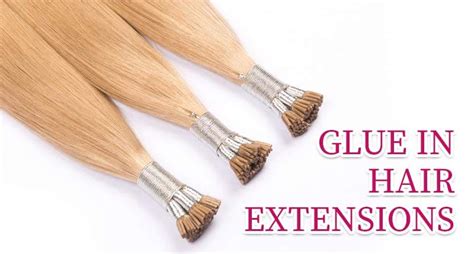Introduction
Extensions have become increasingly popular as a way to add length, volume, and color to hair. However, it is important to choose the right type of glue for your extensions in order to ensure that they stay in place and look natural.

Types of Glue for Extensions
There are two main types of glue for extensions:
- Cyanoacrylate glue: Also known as super glue, cyanoacrylate glue is a fast-acting, strong adhesive that is often used for bonding metal, plastic, and glass. It is also used for bonding hair extensions, but it can be harsh on the hair and scalp and can cause damage if it is not used properly.
- Keratin glue: Keratin glue is a natural protein that is found in hair. It is a weaker adhesive than cyanoacrylate glue, but it is less damaging to the hair and scalp. Keratin glue is often used for bonding hair extensions that are made of human hair.
Choosing the Right Glue
The type of glue that you choose will depend on the type of extensions you have and the desired results. If you have human hair extensions, then you should use keratin glue. If you have synthetic hair extensions, then you can use either cyanoacrylate glue or keratin glue.
It is important to note that cyanoacrylate glue is not recommended for use on sensitive skin or scalp. If you have sensitive skin, then you should use keratin glue.
Applying the Glue
Once you have chosen the right type of glue, you need to apply it correctly in order to ensure that your extensions stay in place.
To apply cyanoacrylate glue, follow these steps:
- Clean the hair and scalp where the extensions will be applied.
- Apply a thin layer of glue to the base of the extension.
- Press the extension into place on the hair.
- Hold the extension in place for 30 seconds to allow the glue to set.
To apply keratin glue, follow these steps:
- Clean the hair and scalp where the extensions will be applied.
- Melt a small amount of keratin glue in a glue gun.
- Apply a thin layer of glue to the base of the extension.
- Press the extension into place on the hair.
- Hold the extension in place for 30 seconds to allow the glue to set.
Removing the Glue
When it is time to remove your extensions, you will need to use a glue remover. There are two types of glue removers:
- Solvent-based glue removers: Solvent-based glue removers contain chemicals that dissolve the glue. They are effective at removing glue, but they can also be harsh on the hair and scalp.
- Oil-based glue removers: Oil-based glue removers contain oils that break down the glue. They are less harsh on the hair and scalp, but they may not be as effective at removing glue.
To remove glue, follow these steps:
- Apply a small amount of glue remover to the base of the extension.
- Allow the glue remover to sit for 10 minutes.
- Gently pull the extension away from the hair.
- Repeat steps 1-3 until all of the glue is removed.
Tips for Using Glue for Extensions
Here are a few tips for using glue for extensions:
- Always do a patch test on a small area of skin before using glue to make sure that you are not allergic to it.
- Do not apply glue to hair that is wet or oily.
- Apply a thin layer of glue to the base of the extension. Do not apply too much glue, or it will be difficult to remove the extensions.
- Press the extension into place on the hair and hold it for 30 seconds to allow the glue to set.
- Do not wash your hair for 24 hours after applying extensions.
Troubleshooting
If you are having problems with glue for extensions, here are a few troubleshooting tips:
- If the extensions are not staying in place, you may not be using the right type of glue. Try using a different type of glue or a stronger adhesive.
- If the glue is causing damage to your hair or scalp, you may be using too much glue or applying it incorrectly. Try using a thinner layer of glue and applying it more carefully.
- If you are having difficulty removing the glue, you may need to use a different type of glue remover. Try using a solvent-based glue remover or a stronger adhesive remover.
Conclusion
Glue for extensions can be a great way to add length, volume, and color to your hair. However, it is important to choose the right type of glue and apply it correctly in order to ensure that your extensions stay in place and look natural.
